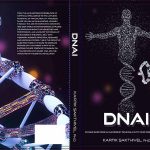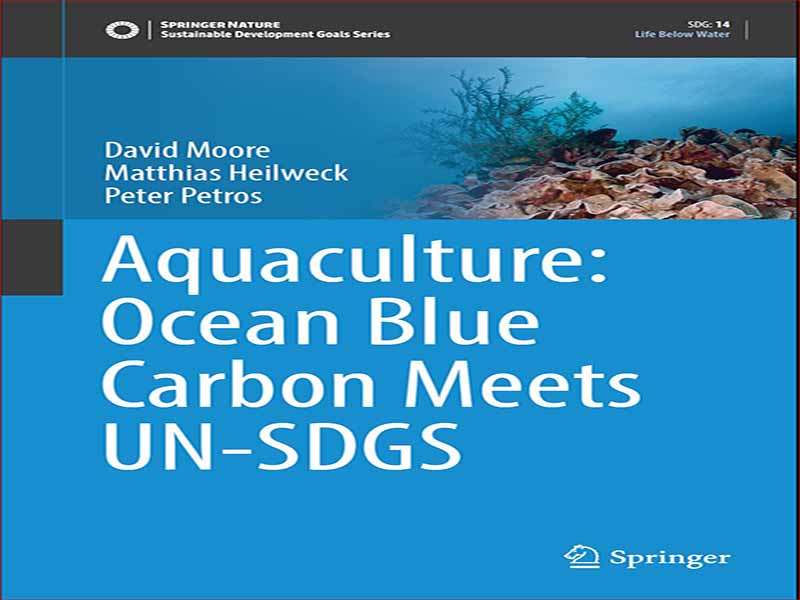- عنوان کتاب: Aquaculture: Ocean Blue Carbon Meets UN-SDGS
- نویسنده: David Moore
- حوزه: اقیانوس
- سال انتشار: 2022
- تعداد صفحه: 268
- زبان اصلی: انگلیسی
- نوع فایل: pdf
- حجم فایل: 10.6 مگابایت
این کتاب در درجه اول برای همه کسانی که مایل به معکوس کردن اثر گلخانه ای است که علت گرم شدن کره زمین و در نتیجه تغییرات آب و هوایی است، هدف قرار گرفته است. از شخص در خیابان گرفته تا دانشجویان کارشناسی و کارشناسی ارشد، دانشمندان ارشد، تصمیم گیرندگان، صاحب نظران و رهبران سیاسی. این کتاب به عنوان واکنشی در میان نویسندگان به ترس های گسترده در مورد انباشت دی اکسید کربن (CO2) در جو ما و گرمایش جهانی ناشی از آن پدید آمد. از آنجایی که CO2 یک گاز گلخانهای است که اجازه خروج انرژی گرمایی مادون قرمز بازتابیده شده از خورشید را نمیدهد، رویدادهایی که گازهای گلخانهای را به جو اضافه میکنند منجر به گرمتر شدن دمای زمین و تغییرات آب و هوایی متعاقب آن میشوند. زمین دارای یک چرخه کربن جهانی است که تعادل طبیعی را حفظ می کند و مانند یک ترموستات عمل می کند و به حفظ دمای زمین در مدت زمان طولانی کمک می کند. این “ترموستات” در بازه های زمانی چند صد هزار ساله کار می کند، بنابراین بخشی از چرخه کلی کربن است. اما در بازههای زمانی کوتاهتر، مثلاً ده هزار تا صد هزار سال، محتوای CO2 جو و در نتیجه دمای زمین، به طور طبیعی میتواند متفاوت باشد و تصور میشود که این یک دلیل کمکی برای جابجایی زمین بین عصرهای یخبندان و دوره های گرمتر بین یخبندان در این بازه های زمانی. بخشهایی از چرخه کربن حتی ممکن است در بازههای زمانی کوتاهتر تغییر کند. چرخه جهانی کربن برای چندین هزار سال تقریباً دقیقاً در تعادل بود، در حالی که انسان ها در حال تکامل بودند و سفر طولانی خود را از آفریقا خارج می کردند. اما سپس انسانهای صنعتی با سوزاندن سوختهای فسیلی مداخله کردند و در نتیجه CO2 را به اتمسفر بازگرداندند که فرآیندهای طبیعی زمین مدتها قبل در سنگها ذخیره کرده بودند. سرعت سریع انقلاب تکنولوژیکی بشر بر چرخه کربن طبیعی با سرعت آهسته تحمیل شده است و باعث افزایش چشمگیر CO2 در اتمسفر در زمان های اخیر شده است که اگر اصلاح نشود، می تواند منجر به تغییرات اقلیمی آنقدر شدید شود که برای بشریت فاجعه بار باشد. . مشکل این است که افزایش مداوم مقدار CO2 در جو ناگزیر باعث ایجاد یک اثر گلخانه ای فراری می شود که باعث افزایش فاجعه بار در دمای سطح زمین می شود. این قبلاً در تاریخ زمین اتفاق افتاده است و توسط فرآیندهای خود زمین اصلاح شده است. شاید ما باید به دنبال آن فرآیندهای طبیعی باشیم تا راه حلی برای مشکل کنونی خود پیدا کنیم. اولین بخش از تاریخ سیاره ما پرکامبرین نامیده می شود. این یک واحد غیررسمی از زمان زمینشناسی است که 88 درصد از طول عمر زمین را پوشش میدهد، از زمان شکلگیری زمین در حدود 4.6 میلیارد سال پیش تا آغاز دوره کامبرین، حدود 550 میلیون سال پیش، یعنی زمانی که اولین فسیلهای قطعی موجودات پوسته سخت ابتدا به وفور یافت می شوند. حیاتی که ما در مورد آن می دانیم احتمالاً پس از برخورد ماه تشکیل شده است، زیرا این باعث شد که زمین برای چند میلیون سال کاملاً عقیم باشد، زمین در اقیانوس عمیقی از ماگما پوشیده شده و در جوی از بخار سنگ احاطه شده است. هنگامی که گوشته جامد شد، بخار در اتمسفر متراکم شد و بارید تا اقیانوسهای داغ (حدود 250 درجه سانتیگراد) شور (نمکی چون NaCl گاز فراوانی در جو بوده است) را تحت فشار اتمسفر حدود 100 برابر جو کنونی ما ایجاد کند. این اتمسفر بیشتر از H2O، CO2 و N2 تشکیل شده بود و شرایط غیرممکن گرم روی سطح تا زمانی که CO2 زمین در اتمسفر باقی می ماند، ادامه می یافت. اما یک اتمسفر ضخیم CO2 اولیه، یک اقیانوس آب مایع و یک پوسته گوشته بازالت تازه، یک تثلیث بسیار واکنش پذیر هستند. تصور میشود که CO2 با سنگهای تازه تشکیلشده کف دریا واکنش داده و کربناتهایی را تشکیل میدهد که در طی یک دوره 20 تا 100 میلیون ساله به گوشته فرورفتهاند. حذف CO2 از اتمسفر به سطح زمین اجازه داد تا آنقدر سرد شود که یخ اقیانوس را پوشانده و «زمین گلوله برفی» را به وجود آورد.
This book is primarily targeted at everyone who wishes to reverse the greenhouse effect that is the cause of global warming and consequent climate change. From the person in the street, to undergraduate and postgraduate students, senior scientists, decision-makers, opinion formers and political leaders. The book arose as a reaction among the authors to the widely circulated fears about the accumulation of carbon dioxide (CO2) in our atmosphere and the resultant global warming. Because CO2 is a greenhouse gas, which does not allow the escape of re-radiated infrared heat energy received from the Sun, events that add greenhouse gases into the atmosphere result in warmer temperatures on Earth and consequential climate change. The Earth has a Global Carbon Cycle that maintains a natural balance and acts like a thermostat, helping to keep Earth’s temperature relatively stable over long periods of time. This ‘thermostat’ works over timescales of a few hundred thousand years, so it’s a slow part of the overall carbon cycle. But over shorter time periods, say ten thousand to a hundred thousand years, the CO2 content of the atmosphere, and consequently the temperature of Earth, can quite naturally vary and this is thought to be a contributory cause for the Earth shifting between ice ages and warmer interglacial periods over these timescales. Parts of the carbon cycle may even vary over shorter timescales. The Global Carbon Cycle was almost exactly in equilibrium for several thousand years while humans were evolving and taking their long trek out of Africa. But then industrial humans intervened by burning fossil fuels, thereby returning to the atmosphere CO2 that the Earth’s natural processes had stockpiled in the rocks long before. The rapid pace of the human technological revolution has been imposed upon the slow-paced natural Carbon Cycle, causing such a dramatic increase in atmospheric CO2 in recent times that, if not corrected, could result in climate change so extreme as to be catastrophic for humanity. The problem is that continued increase in the amount of CO2 in the atmosphere will inevitably cause a ‘runaway greenhouse’ effect that will generate catastrophic increase in the Earth’s surface temperatures. This has happened before in the history of the Earth and has been corrected by the Earth’s own processes. Perhaps we should look to those natural processes to find the cure for our present predicament. The earliest part of our planet’s history is called the Precambrian. This is an informal unit of geologic time that covers 88% of the Earth’s lifetime, extending from the formation of Earth about 4.6 billion years ago to the beginning of the Cambrian Period, about 550 million years ago, which is when the first definitive fossils of hard-shelled creatures are first found in abundance. The life we know about probably arose on Earth after the Moon-forming impact because this made Earth absolutely sterile for a couple of million years, with Earth covered in a deep ocean of magma and enveloped in an atmosphere of rock vapour. When the mantle solidified, steam in the atmosphere condensed and rained out to make hot (about 250° C) salty oceans (salty because NaCl had been an abundant gas in the atmosphere) under an atmospheric pressure about 100 times that of our present atmosphere. This atmosphere was composed mostly of H2O, CO2 and N2, and the impossibly hot conditions on the surface would have lasted while Earth’s CO2 remained in the atmosphere. But a thick primordial CO2 atmosphere, a liquid water ocean and a fresh basalt mantle crust are a highly reactive trinity. It is thought that the CO2 reacted with the newly formed rocks of the seafloor forming carbonates that were subducted into the mantle over a period of 20 to 100 million years. Removal of CO2 from the atmosphere allowed the Earth’s surface to cool so much that ice covered the ocean and ‘Snowball Earth’ resulted.
این کتاب را میتوانید از لینک زیر بصورت رایگان دانلود کنید:


































نظرات کاربران